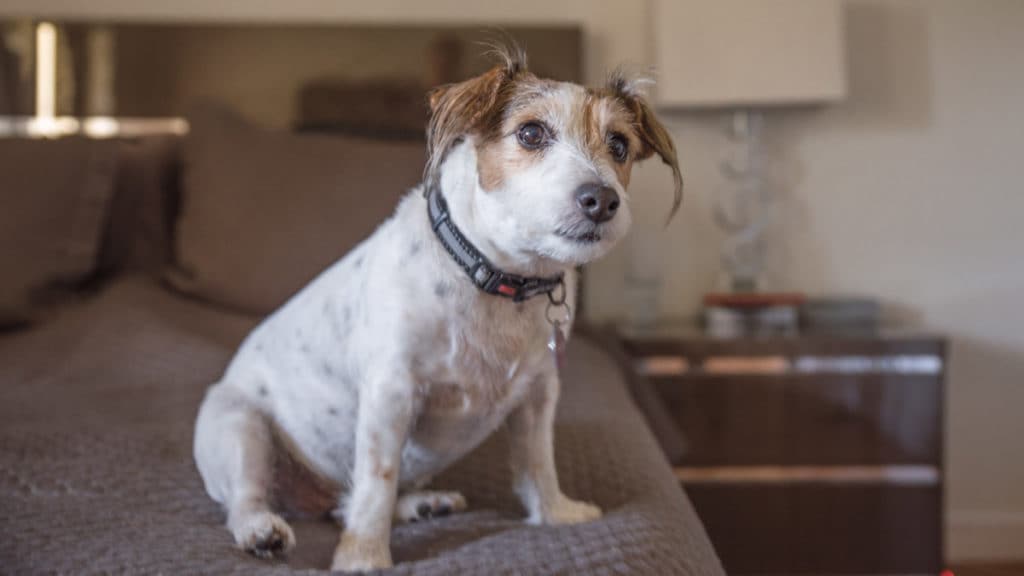Dogs are considered “man’s best friend” thanks to their quick learning abilities, eagerness to please and loyal nature. But what happens when the positive traits that make your pet such a dependable friend coincide with his territorial nature and instinct to guard? We’ve all been in situations where we’ve either experienced or witnessed an aggressive dog protecting a person, place or thing, accompanied by a distressed owner. Understanding the underlying cause of your dog’s actions is essential in ensuring the safety of you, your dog and those around you. With a few easy pointers to get your four-legged best friend back on the right behavior track, you can learn how to train your dog to curb territorial tendencies before these behaviors have a chance to turn aggressive.
Dealing with unwanted dog behavior can be challenging—it takes understanding, patience and consistency over time to correct a natural instinct. It’s important to note that our human cues can be misleading to a dog and can create miscommunication between pet and owner. For instance, we may praise a barking dog that reacts when strangers approach our home, but then we find it troublesome when a new guest visits and our pup becomes territorial. Early detection and training can provide the ideal solution for unwanted behaviors, but it can be difficult to identify the signs until they manifest into larger problems. According to Paula Nowak, CPDT-KA, CTDI, Head Trainer and Behavior Consultant at Canine Country Academy in Lawrenceville, GA, “Dogs frequently act out…due to fear. [If] they lacked positive experiences with new people as a young dog,…they [may] find new…interactions scary. The lack of exposure in a positive way, during [a] critical learning window, can greatly impact…responses later in life.” Pinpointing the underlying root of the problem and identifying territorial dog behavior early on is key to addressing specific types of dog aggression and trouble areas to correct them with proper training.
Every dog is unique and displays signs of territorial aggression differently. This can vary from a dog bite, growl, bark, lunge, etc., and may be a reaction to a multitude of variables. From the excitement of a doorbell ringing, to encountering new people, dogs, or a moving object, it’s critical to identify the cause of the unwanted dog behavior in order to alter it. Start small by identifying the exact trigger and work toward slowly desensitizing your pup by assigning a different, positive behavior to the trigger, followed by a reward for his obedience. To do so, expose your pup to the stimuli at a low, manageable level while staying below the threshold that would cause him to react. Distraction is a great way to begin gradually re-training. For example, if your pup barks at the sight of joggers running past, call his name to get his attention. At first, your dog may only look at you. Although this may seem like a small step, it is progress in the right direction, and should be greatly rewarded. In addition to positive reinforcement, the Sentry Stop That! Noise & Pheromone Dog Spray is a great training tool that combines a distracting noise with pheromones to calm and refocus your pet.
In the early stages of corrective training (and depending on your pup’s particular triggers), try working with your pooch in the comfort and familiarity of your home to obtain a grasp on your pet’s responses before progressing outside. When moving training outdoors, keep in mind the variety of factors that can quickly change, and be sure to equip yourself with the proper tools for the combined success of you and your dog. The PetSafe Premier Gentle Leader Quick Release Dog Headcollar helps you comfortably guide your pooch without straining his neck or chest and comes in a variety of sizing options. A dog’s natural instinct is to tug and keep tension on the lead. The mentality behind the head collar is that a dog moves forward by leading with his snout. By redirecting his nose, you are able to control his direction and better guide him while ceasing his tendency to pull.
A dog has a natural tendency to protect what he perceives as “his.” Early training and socialization is ideal when considering how to train your dog to prevent undesirable behavior. You should also be aware of other factors that may cause your pooch to act a certain way. Underlying problems, such as a medical condition, fear or anxiety about a real or perceived threat, sexual maturation, pack behavior, etc. can all come into play. “Rule out any medical issue that may be contributing to the behavior,” says Nowak. If you feel your pet may be suffering from a physical ailment or need medical attention, contact your veterinarian immediately. As your dog matures, keep an eye out for early indicators of troublesome behavior. With the help of consistent, positive training and the right tools for the job, you can help teach your furry best friend the proper manners that will make life more safe and enjoyable for all.
Share:











